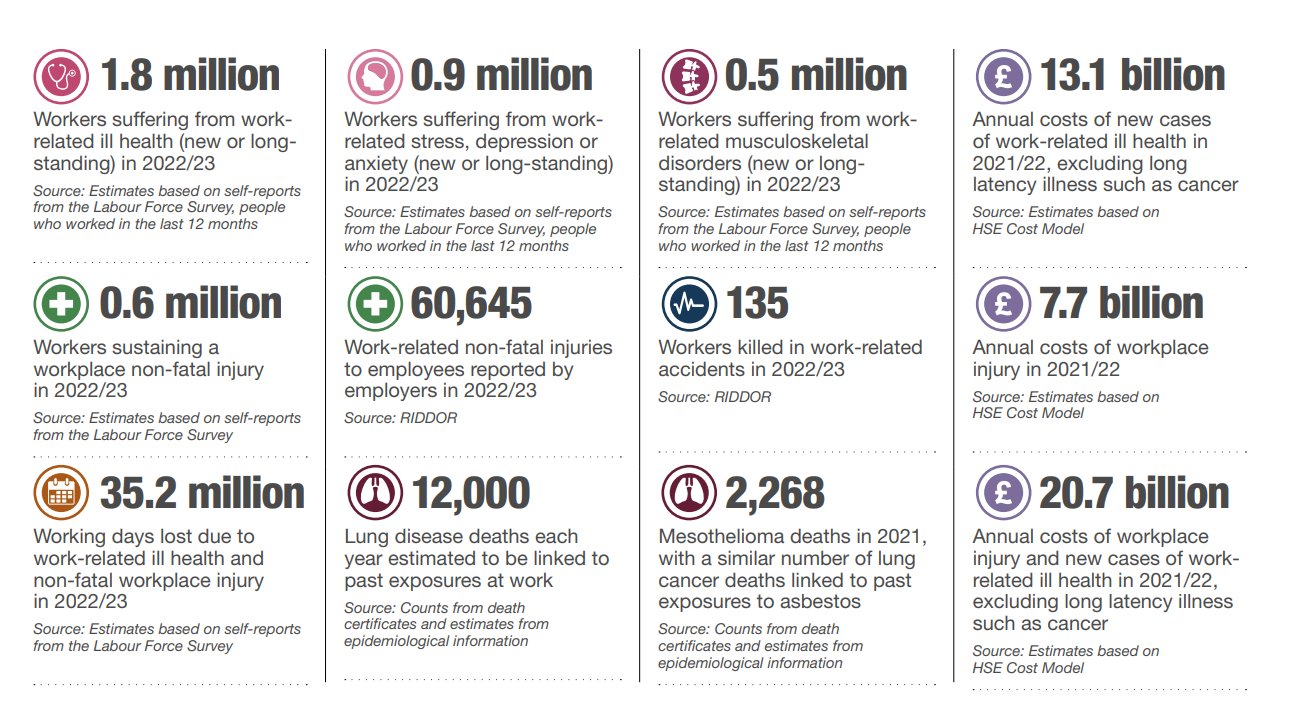
HSE publishes annual work-related ill health and injury statistics for 2022/23
The Health and Safety Executive (HSE) has today published its annual statistics on work-related ill health and workplace injuries, revealing that nearly two million workers in Great Britain reported suffering from work-related ill health in 2022/23.
In addition, 1.8 million workers reported they were suffering from work-related ill health in 2022/23, with approximately half of the cases down to stress, depression or anxiety.
In the recent years prior to the COVID-19 pandemic, the rate of self-reported work-related ill health had been broadly flat, but the current rate is higher than 2018/19.
There were an estimated 875,000 cases of work-related stress, depression or anxiety in 2022/23. The current rate of self-reported work-related stress, depression or anxiety is higher than the pre-pandemic level.
An estimated 35.2 million working days were lost in 2022/23 due to self-reported work-related ill health or injury.
HSE’s chief executive Sarah Albon said:
“Preventing or tackling work-related stress can provide significant benefits to employees, improving their experience of work and their overall health, and also to employers including increased productivity, decreased absenteeism and reduced staff turnover.”
HSE’s statistics also reveal the impact work-related ill health and workplace injuries are having on Britain’s economic performance.
In 2021/22, the estimated annual costs of workplace injury and new cases of work-related ill health reached £20.7bn, representing a £1.9bn increase compared with 2019/20.
The figures also show that 135 workers were killed in work-related accidents in 2022/23, while 561,000 workers sustained a self-reported non-fatal injury in the workplace during the same period.
Kate Gardner, health and safety trainer at International Workplace, advises employers what to do to look after the wellbeing of employees who are still working from home or on a hybrid working pattern:
"Homeworking can cause work-related stress and affect people’s mental health. Being away from managers and colleagues can make it difficult to get proper support. The HSE advises that managers should put procedures in place so they can keep in direct contact with homeworkers and recognise signs of stress as early as possible. It is also important to have an emergency point of contact and to share this so people know how to get help if they need it. Fundamentally, the principles of an employer’s duty of care to be met are the same, regardless of the working location of the employee. Employers have the same responsibilities for employees working at home as they do for staff in the workplace.
Boundaries between work and home life have become increasingly blurred for many people working from home, making it difficult to switch off. For those attending workplaces, presenteeism and leaveism are also very real issues of concern. Organisations must address any issues that could be creating a culture where staff feel they are expected to work when ill or feel it’s the only way they can stay on top of their workload. Employers need to ensure that line managers are aware of the risks of presenteeism and being ‘always on’. Managers should assess individual and team workloads to make sure they are reasonable, set clear expectations about taking breaks, and act as good role models for healthy working practices, such as taking time off when sick."
The IOSH Managing Occupational Health and Wellbeing, brought to you by International Workplace, is the management training solution to help you address issues such as stress and wellbeing effectively and ensure your teams remain happy, healthy and productive. All of the information in this guide has been taken from the course, which is available via eLearning or as a one-day virtual classroom course.
Find out more here.







